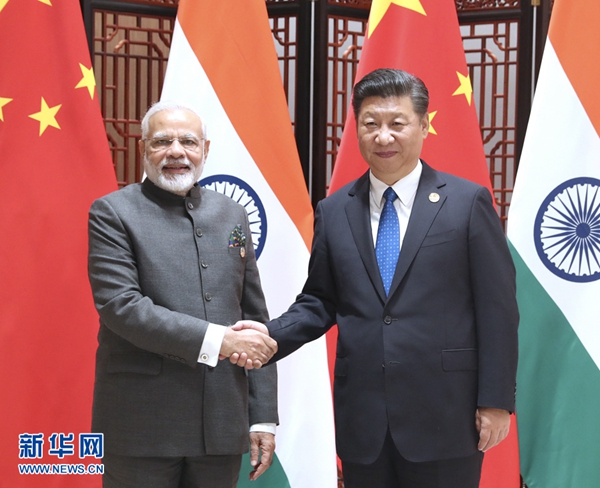Modi-Xi meeting is chance to turn over a new leaf
- By Rabi Sankar Bosu
 0 Comment(s)
0 Comment(s) Print
Print E-mail China.org.cn, September 12, 2017
E-mail China.org.cn, September 12, 2017
|
|
|
Chinese President Xi Jinping meets with Indian Prime Minister Narendra Modi in Xiamen on Sept. 5, 2017. [Xinhua] |
Indian Prime Minister Narendra Modi's participation in the 9th Annual Summit of BRICS (comprising Brazil, Russia, India, China and South Africa) in the picturesque Chinese coastal city of Xiamen and his first substantive bilateral meeting with Chinese President Xi Jinping was a huge step forward.
Coming after the 73-day Donglang (Doklam) border standoff, the Modi-Xi meeting has taken bilateral relations of India and China to new heights, and will surely bring about great changes in the region, both politically and diplomatically, going beyond the BRICS mechanism.
We saw how the two leaders shook hands warmly, smiled, talked about “peaceful coexistence and win-win cooperation” and agreed to follow “the Five Principles of Peaceful Coexistence” for their strategic partnership.
This was Modi's third visit to China as prime minister since taking office in 2014. He made a bilateral visit on May 14-16, 2015 and then traveled again in September 2016 to attend the G20 Summit in Hangzhou. This year alone, it was the third encounter between Modi and Xi after the Shanghai Cooperation Organization Summit in Astana in June and G20 Summit in Germany on July 7.
Meeting on the sidelines of the BRICS Summit, they sent positive signals about bilateral ties. The meeting came after a military stand-off between soldiers from the two sides in the Donglang area of the Sikkim sector of the China-India border severely strained relations.
According to the Chinese Foreign Ministry, the standoff began on June 18 after some 270 Indian border troops crossed into the Donglang area, over which China has indisputable sovereignty according to the Convention Between Great Britain and China Relating to Sikkim and Tibet signed in 1890.
By August 28, 2017, India had withdrawn all its border personnel and equipment from Donglang, to everyone's relief.
During the meeting, President Xi pointed out that healthy and stable relations between China and India were in line with the fundamental interests of their respective peoples. He called for putting ties with India on the "right track" and said the two countries should pursue "healthy, stable bilateral ties.”
The Chinese president also stated that the two countries should not see each other as competitors, but should rather focus on opportunities present for both sides to develop and explore. He said China was prepared to work with India based on the five principles of the Panchsheel Treaty signed between them in 1954. Panchsheel calls for non-aggression and respecting sovereignty.
Modi said India was ready to work with China to develop stable ties by maintaining close communication. He also congratulated Xi on a "very successful" BRICS Summit. After the big meeting, the Indian premier tweeted: "We held fruitful talks on bilateral relations," while Foreign Secretary S. Jaishankar described the meeting as "forward-looking."
It is also worthy of note that both countries agreed Chinese and Indian defense and security personnel must maintain strong contacts and cooperation so as to prevent further incidents like the Donglang stand-off.
Undoubtedly, it can be said that frequent interactions between the two leaders had greatly promoted pragmatic cooperation and enhanced political mutual trust. More importantly, the two leaders have surpassed their personal differences and have advocated economic and social development.
China and India, as important neighbors, can help build on their relationship through multilateral institutions like BRICS, SCO and the Chinese-backed Asian Infrastructure Investment Bank. Undoubtedly, there is great potential for cooperation in various fields.
The two countries are biggest developing and emerging markets. Economic cooperation has become even more important against the backdrop of rising anti-globalization and anti-free trade trends in the world.
The bilateral economic and trade cooperation between China and India has entered a new stage with the trade volume exceeding US$70 billion last year and China becoming India's largest trading partner.
Peaceful coexistence and win-win cooperation should be an inevitable choice and correct direction of China-India ties amid the mounting global challenges as well as the increasing uncertainties and instability in the international landscape. There should be no race between the two countries.
As Chinese Foreign Minister Wang Yi pointed out, the two sides should strengthen mutual trust and treat each other as development opportunities and partners, not opponents and a threat.
Rabi Sankar Bosu, secretary of New Horizon Radio Listeners' Club, West Bengal, India
Opinion articles reflect the views of their authors only, not necessarily those of China.org.cn.







Go to Forum >>0 Comment(s)